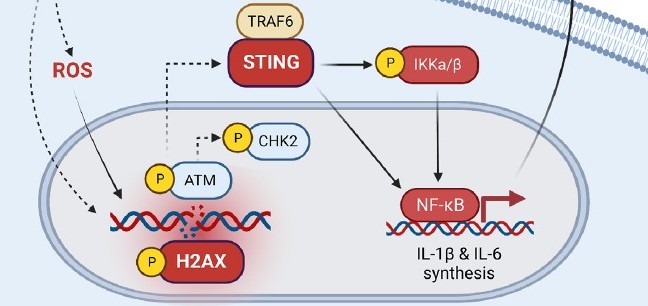Bold Findings About Blood Cell Formation Stir the Scientific Pot
Research By: H. Leighton (Lee) Grimes, PhD | Nathan Salomonis, PhD
Post Date: June 30, 2019 | Publish Date: Sept. 29, 2016

Leighton Grimes, PhD, describes his team’s recent insights into how blood cells determine their developmental fate as a genetic tug of war.
As early-stage progenitor cells develop into the various components of our blood, they do so amid a swirl of genetic turbulence, or dynamic instability, which can be observed by turning on alternate lineage genes in individual cells.
The cells briefly exist in these multi-lineage states, and sometimes in a less common bi-stable state, before moving on to become neutrophils, monocytes, etc. The ultimate fate of the cell is determined through a competition between opposing gene regulatory networks.
By finding gene networks that appear to regulate normal blood cell formation, the team also suggests that miscues in this process may explain a great deal about a variety of blood and immune system disorders. Grimes and colleagues detailed their theory in a paper published in Nature in August 2016—and set the scientific community abuzz.
“While the data were initially controversial, the paper has been cited 31 times,” Grimes says. “The study is making a contribution and people still discuss it at scientific meetings because others are finding similar results.”
DEEP VS. WIDE DEBATE IN BLOOD DISORDERS RESEARCH
The paper was a collaboration between Grimes, Harinder Singh, PhD, Director of Immunobiology, and Nathan Salomonis, PhD, Biomedical Informatics. The study infers that within these genetic tugs of war, other as yet undiscovered multi-lineage intermediates likely exist.
The team used emerging single-cell RNA sequencing technology, which can identify different genes and regulatory networks within individual cells, as a critical tool for reaching their conclusions. However, scientists sometimes disagree over how best to use the tool.
Some researchers favor sequencing and analyzing thousands of cells without diving as deeply into the different genes that are switching on and off. However, the Cincinnati Children’s team opted to sequence only about 500 cells. They probed much more deeply into the gene expression patterns and regulatory networks involved in the blood cell tug of war.
“This is a major conversation around sequencing thousands of cells at low depth versus fewer cells at deeper depth,” Singh says.
TAPPING A BIOINFORMATICS PIPELINE
However, the Cincinnati Children’s project involved more than single-cell RNA sequencing to draw its conclusions.
Among the other experiments involved: a new bioinformatics pipeline developed by Salomonis called Iterative Clustering and Guide-Gene Selection (ICGS). This automated platform helps scientists process and analyze all of the single-cell RNA sequencing data to identify the transitioning or shifting genomic states of cells.
“Our analysis captured prevalent mixed-lineage intermediates that manifested coincident expression of hematopoietic stem cell/progenitor (HSCP) and myeloid progenitor genes,” the co-authors say. “It also revealed rare metastable intermediates that had collapsed the HSCP program and expressed low levels of the myeloid determinants, Irf8 and Gfi1.”
ICGS resolved nine hierarchically-ordered cellular states, and further analysis detailed their cellular identities: HSCP-1 (Hematopoietic Stem Cell Progenitor), HSCP-2, Meg (Megakaryocytic), Eryth (Erythrocytic), Multi-Lin* (Multi-Lineage Primed), MDP (Monocyte-Dendritic cell precursor), Mono (Monocytic), Gran (Granulocytic) and Myelocyte (myelocytes and metamyelocytes).
“Strikingly, the unbiased ICGS analysis inferred a developmental order in agreement with the experimentally determined hematopoietic sequence,” the authors wrote.
Now the ICGS platform is attracting interest from other research centers.
“A number of other researchers are using bioinformatics tools that we developed to test new hypotheses,” says Salomonis. “We also are in touch with other research groups who are using data we generated in the Nature paper to test different hypotheses for the exact cell populations we describe.”
| Original title: | Single-cell analysis of mixed-lineage states leading to a binary cell fate choice |
| Published in: | Nature |
| Publish date: | Sept. 29, 2016 |
Research By








